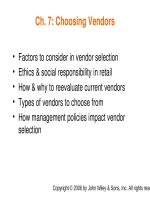Lecture Management information systems - Chater 14: Enterprise and global management of information technology
Bạn đang xem bản rút gọn của tài liệu. Xem và tải ngay bản đầy đủ của tài liệu tại đây (1.63 MB, 64 trang )
Copyright © 2006, The McGrawHill Companies, Inc. All rights reserved.
14 - 1
Chapter
14
Enterprise & Global
Management of Information
Technology
Copyright © 2006, The McGrawHill Companies, Inc. All rights reserved.
14 - 2
Learning Objectives
1. Identify each of the three components of
information technology management
and use examples to illustrate how they
might be implemented in a business.
2. Explain how failures in IT management
can be reduced by the involvement of
business managers in IT planning and
management.
Copyright © 2006, The McGrawHill Companies, Inc. All rights reserved.
14 - 3
Learning Objectives
3. Identify several cultural, political, and
geoeconomic challenges that confront
managers in the management of global
information technologies.
4. Explain the effect on global business/IT
strategy of the trend toward a
transnational business strategy by
international business organizations.
Copyright © 2006, The McGrawHill Companies, Inc. All rights reserved.
14 - 4
Learning Objectives
5. Identify several considerations that
affect the choice of IT applications, IT
platforms, data access policies, and
systems development methods by a
global business enterprise.
Copyright © 2006, The McGrawHill Companies, Inc. All rights reserved.
14 - 5
Why Study IT Management?
• As the 21st century unfolds, many
companies throughout the world are intent
on transforming themselves into global
business powerhouses via major
investments in global e-business, ecommerce, and other IT initiatives.
Copyright © 2006, The McGrawHill Companies, Inc. All rights reserved.
14 - 6
Case #1: Managing IT
Reasons for Failure:
• Ancient, unreliable, undocumented
infrastructure
• Lacking project and budget controls
• Substandard quality control
• IT full of silos and fiefdoms
• No economies of scale
Copyright © 2006, The McGrawHill Companies, Inc. All rights reserved.
14 - 7
Case #1: Managing IT
1. What were several major reasons the IT
organization had failed at the Chicago
Board of Trade? Explain the impact of
each on CBOT.
2. What were several key management
changes and initiatives that Bill Farrow
implemented to make IT successful at
CBOT? Explain the impact of each on
CBOT.
Copyright © 2006, The McGrawHill Companies, Inc. All rights reserved.
14 - 8
Case #1: Managing IT
3. Does the experience of CBOT prove that
“IT is a business function that needs to
be managed like any other business
function?” Why or why not?
4. What role should a company’s
executives and business unit managers
play in managing the IT function in a
business? Why?
Copyright © 2006, The McGrawHill Companies, Inc. All rights reserved.
14 - 9
Components of IT Management
Copyright © 2006, The McGrawHill Companies, Inc. All rights reserved.
14 - 10
Conventional vs. E-business IT
Management
Copyright © 2006, The McGrawHill Companies, Inc. All rights reserved.
14 - 11
Business/IT Planning Process
Copyright © 2006, The McGrawHill Companies, Inc. All rights reserved.
14 - 12
Components of Business/IT Planning
• Strategy Development – developing business
strategies that support a company’s business
vision
• Resource Management – developing strategic
plans for managing or outsourcing a company’s
IT resources
• Technology Architecture – making strategic IT
choices that reflect an information technology
architecture designed to support a company’s
business/IT initiatives
Copyright © 2006, The McGrawHill Companies, Inc. All rights reserved.
14 - 13
Information Technology Architecture
• Technology Platform – Networks, computer
systems, system software and integrated
enterprise application software provide a
computing and communications infrastructure,
or platform, that supports the strategic use of
information technology for e-business, ecommerce, and other business/IT applications
• Data Resources – operational and specialized
databases store and provide data and
information for business processes and decision
support
Copyright © 2006, The McGrawHill Companies, Inc. All rights reserved.
14 - 14
Information Technology Architecture
• Applications Architecture – integrated
architecture of enterprise systems that
support strategic business initiatives as
well as cross-functional business
processes
• IT Organization – organizational structure
of the IS function within a company and
the distribution of IS specialists are
designed to meet the changing strategies
of a business
Copyright © 2006, The McGrawHill Companies, Inc. All rights reserved.
14 - 15
Strategic vs. Application Planning
Copyright © 2006, The McGrawHill Companies, Inc. All rights reserved.
14 - 16
Organizational Components of IT
Copyright © 2006, The McGrawHill Companies, Inc. All rights reserved.
14 - 17
Application Development Management
Definition:
• Managing activities such as systems
analysis and design, prototyping,
applications programming, project
management, quality assurance, and
system maintenance for all major
business/IT development projects
Copyright © 2006, The McGrawHill Companies, Inc. All rights reserved.
14 - 18
IS Operations Management
Definition:
• Use of hardware, software, network, and
personnel resources in the corporate or
business unit data centers of an
organization
Copyright © 2006, The McGrawHill Companies, Inc. All rights reserved.
14 - 19
System Performance Monitors
Definition:
• Software packages that monitor the
processing of computer jobs, help
develop a planned schedule of computer
operations that can optimize computer
system performance, and produce
detailed statistics that are invaluable for
effective planning and control of
computing capacity
Copyright © 2006, The McGrawHill Companies, Inc. All rights reserved.
14 - 20
Chargeback Systems
Definition:
• Output of a system performance monitor
that allocates costs to users based on the
information services rendered
Copyright © 2006, The McGrawHill Companies, Inc. All rights reserved.
14 - 21
Process Control Capabilities
Definition:
• Performance monitoring systems that not
only monitor but automatically control
computer operations at large data centers
Copyright © 2006, The McGrawHill Companies, Inc. All rights reserved.
14 - 22
Human Resource Management of IT
• Recruit qualified personnel and develop, organize, and
direct the capabilities of existing personnel
• Continually train employees to keep up with the latest
developments in a fast-moving and highly technical field
• Continually evaluate employee job performances and
reward outstanding performances with salary increases
and promotions
• Set salary and wage levels and design career paths so
individuals can move to new jobs through promotion and
transfer as they gain in seniority and expertise
Copyright © 2006, The McGrawHill Companies, Inc. All rights reserved.
14 - 23
Chief Information Officer
Job Description:
• Oversees all uses of information
technology in many companies, and
brings them into alignment with strategic
business goals
Copyright © 2006, The McGrawHill Companies, Inc. All rights reserved.
14 - 24
Technology Management
Definition:
• Information technologies managed as a
technology platform for integrating
internally focused or externally facing
business applications
Copyright © 2006, The McGrawHill Companies, Inc. All rights reserved.
14 - 25









